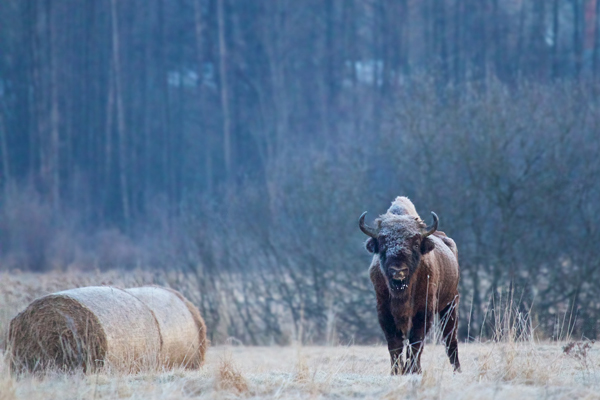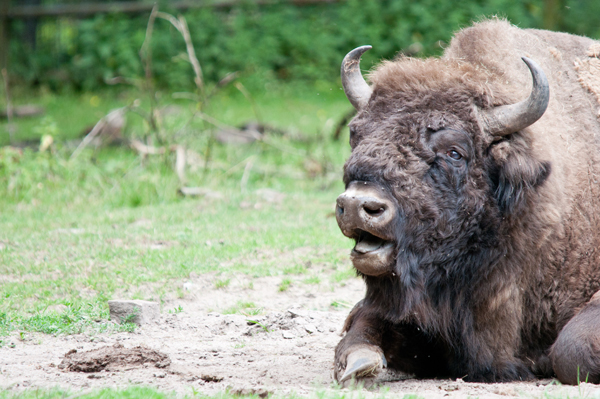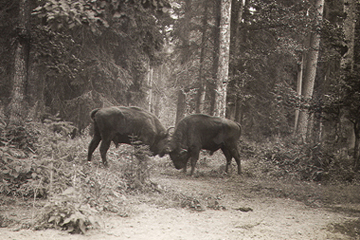We’d been hiking through deep snow all day with the mercury well below zero, not an uncommon occurrence during winter in eastern Poland. Still I was sweating, covered in several layers and walking with greater strides than I was used to. We stopped once for lunch, taking our repast on a snow-covered log, eating our sandwiches and drinking greedily from our flasks, the tea still piping hot. All strangers until the day before, we chatted, laughed a little, then followed the trail onwards through the edges of Białowieża Forest.
On a path flanked by thick woods, I first spied our quarry. When she appeared, far away between the long verticals of bare trees, I could hardly believe she was there. She was a ghost, a specter haunting this winter forest. Her horns were prettily curved, her face slender, her whole 400 kilogram (880 pound) mass framed by the trees. She eyed us with that wariness only prey species have, a super-abundance of caution, and if she had run we would have easily lost her amidst the forest. But she didn’t flee. Instead she stood still, puffs of breath emanating from her nose, for a few minutes. It’s a moment I will never forget: a continent’s megafauna in the flesh.

European bison running across a trail in Białowieża Forest. Photo by: Lukasz Mazurek/Wild Poland.
European bison (Bison bonasus), or wisent as they are also called, very nearly became real ghosts. Instead, the last half-century has marked an incredible comeback story. The species—the biggest land animal in Europe—has gone from total extinction in the wild in 1927 to over 5,000 bison today, including 2,300 free-ranging animals. And one of those was the wild female I saw in Poland on that cold winter day.
“It is as important to Europe as the American bison for America, the Komodo dragon for Oceania, the polar bear for the Arctic, the gorilla for Africa or the giant panda and tigers for Asia,” said Lukasz Mazurek, a naturalist and founder of Wild Poland, a wildlife tourism company in the Białowieża region. “Don’t get me wrong, I know there are other species even more endangered than the European bison… But would our world be the same without them?”
Wisent history

Painting of embattled European bison. Painting by: London, F. Warne, 1893-1896/Biodiversity Heritage Library/Creative Commons 2.0
Let’s go back around 12,000 years to the Pleistocene. At the time, the European bison appears to have roamed from France in the west to deep into Russia in the East—though there is still debate on the breadth of their range. To the north, they inhabited southern Scandinavia while to the south they may have even ventured into the Italian Alps. They were hunted by Europe’s earliest humans and a favorite subject in Paleolithic art. Yet, their time was coming to a rapid end: the explosion of the human population and the rise of farming decimated the bison. Habitat destruction and overhunting wiped out one population after another until only a few populations held on, but barely.
At the same time, their fellow megafauna were winking out across the continent. Many of the top predators were already gone, but the woolly mammoth and woolly rhino disappeared from Europe around 10,000 years ago, the closely-related steppe bison around 9,000 years ago, and the Irish elk about 7,000 years ago. The auroch—wild, bulky cattle that were domesticated into today’s multifarious breeds—survived thousands of years longer, the last one perishing in a Polish forest in 1627.

Bull European bison in Białowieża Forest photographed in March. Photo by: Lukasz Mazurek/Wild Poland.
The European bison could have whispered a similar story from the grave. By the nineteenth century only two populations remained: one in the Caucuses and the other in Poland’s Białowieża Forest. Herds only survived in Białowieża due to the will of kings, both Polish and Russian. From the 15th Century onwards, the Białowieża Forest was royal hunting grounds, protecting the forest, a few hundred bison, and many other species with its imperial status.
But the onslaught of World War I eventually led to the slaughter of Białowieża’s last bison. Occupying German soldiers killed off hundreds, while the final nine were likely poached by hungry locals. By 1919—one year after the armistice—the great forest was emptied. A single population survived in the Caucasus, but was exterminated by hunters in 1927. The European bison—which once roamed across much of Europe and into Asia—was gone from the wild. But it was not extinct. The species was saved, quite literally, by zoos.
From just 12 founding animals—11 from Białowieża and one from the Caucuses—conservationists meticulously bred the species across five zoos, splitting them into two genetic lines: the main lowland bison, and another group that mixed lowland bison with the lone Caucasian survivor. Over the ensuing decades they built the population up.
In 1952 a new chapter began for the European bison. Two dozen years after the last bison were hunted out, conservationists returned two bulls to Białowieża Forest and several cows soon after. This release would prove the beginning of a wildly successful reintroduction effort (pun intended).
Comeback kid

Release of European bison in Romania. Photo by: Staffan Widstrand/Rewilding Europe.
Today, free-ranging European bison are found in nine countries, as far west as Germany and as far east as Russia. The largest population remains in Białowieża, which extends into Belovezhskaya Pushcha National Park in Belarus. Once extinct in the wild, the European bison are now considered Vulnerable by the IUCN.
The most recent country to welcome back the bison was Romania, where the species vanished in 1862. In 2012, conservationists released five animals into Vanatori Neamt Nature Park. Since then conservationists have released 22 more in the Eastern European country and they are breeding.
“Our intention…is not only to reestablish a keystone species in the ecological sense but also in a spiritual and cultural sense,” said Sebastian Catanoiu, the director of Romania’s Vanatori Neamt Nature Park.
He explained that “according to legends, the foundation of the medieval state of Moldova happened during a bison hunt close to the [park]—at that time known as the ‘Bison Land.’ Since then the bison serves as the symbol of Moldova and is also represented on the Romanian flag.”

Happy bison after a release in Romania. Photo by: Staffan Widstrand/Rewilding Europe.
Echoing Catanoiu’s sentiment, Mazurek of Wild Poland said that when bison return they quickly become a part of local culture.
“Bison are not only growing in numbers here, but they have also made it into the people’s minds.”
In Białowieża “there is none or hardly any poaching…and even the local farmers and foresters seem to respect them and understand their role and value in the ecosystem,” Mazurek went on to say. “They now firmly exist in both the natural ecosystem in the biological meaning and the total ecosystem including the people, their economy and development. I think this is a great success.”
Helping people and biodiversity
The return of the bison has aided both the wider environment and human livelihoods. Ecologists now know that big animals—such as top predators and heavy-weight herbivores—play a vital role in shaping and maintaining an ecosystem.

Bison in Bialowieza Forest. Today around 800 wild bison survive in Bialowieza. Photo by: Lukasz Mazurek/Wild Poland.
According to Wouter Helmer, the Rewilding Director with the NGO Rewildling Europe, the European bison “is of crucial importance in ‘building’ natural landscapes and therefore for European biodiversity. Several thousands of smaller species are dependent on the structuring of vegetations by bison, their sand baths, tracks, manure, and carcasses.”
The European bison has become a popular target of rewilding campaigns for another reason as well: tourism.
The bison is an “attraction in itself,” said Helmer, one that is now “attracting tourists from outside to these often remote areas and thus becoming a new base for a rural economy.”
Today, tour guide and business owner, Mazurek, makes a living from this comeback kid.
“Business wise, [the bison] is the core of everything we do,” he said, adding that the “the main reason why people visit [Białowieża] is the primeval forest and the bison, nothing else.”

Bison and winter scene in Bialowieza. Photo by: Lukasz Mazurek/Wild Poland
Still, Mazurek noted that the Polish government has been slow to recognize the economic importance of the bison, complaining that Polish president Bronislaw Komorowski bypassed the park on a recent visit to the region.
“His meeting with foresters who keep chopping the primeval forest down…was more important,” Mazurek said. The majority of the Białowieża Forest is still logged by the state forestry company, though a core, old-growth area remains protected.
The bison are not just a paycheck for Mazurek, who noted the big mammals have given him “some of my most magical experiences out in the wild.” The same experiences tourists hope for when they visit Białowieża Forest.
Rare but upbeat
Still, for all the success in bringing back the species, the European bison is not wholly out of the woods yet (pun also intended).
The European bison is “[rarer] than the black rhino [which is] recognized as an endangered species and iconic for nature conservation,” said Rafal Kowalczyk, the director of the Mammal Research Institute at the Polish Academy of Sciences and an expert on bison ecology.
Rewilding Europe director Helmer pointed out that despite nearly a hundred years of conservation work there are still only a few big populations in the wild. He added that the top challenge “is to get enough self-sustainable populations…in different areas, different habitats, also to spread risks if a disease or other catastrophe appears.”

Bull bison in Białowieża Forest. Photo by: Lukasz Mazurek/Wild Poland.
Catastrophe is certainly a possibility. For example, blue tongue disease, which is transmitted from local cattle to the bison via mosquitoes, killed two reintroduced bison in Romania last year.
Another concern is lack of genetic diversity given the bison’s near extinction. But Helmer said that growing populations of disconnected bison groups could provide the species a more robust genetic profile over time.
Despite these challenges, however, the wisent’s future prospects remain generally bright. Wild bison may be rarer than wild black rhinos and wild tigers, but unlike these species they aren’t facing a prolonged poaching crisis or massive habitat destruction.
Forest or range?
Still, even after decades of research and rewilding, questions remain. The biggest: is the European bison, sometimes even called the wood bison, actually most at home in forest habitats as traditionally thought or does the species prefer more open, park-like environs?
It’s not surprising that conservationists long believed European bison were happy forest dwellers, given that the last individuals survived only in dense, protected forest habitat. But some scientists now believe the bison actually prefer grasslands, and that their persistence in forests was simply because these areas provided the only protection left against two-legged hunters with arrows and guns.

Bison in Zuid-Kennemerland National Park where the species inhabits grasslands and dunes instead of forest. Photo by: Staffan Widstrand/Rewilding Europe.
A top bison expert, Kowalczyk, is one of the researchers who ascribe to the open habitat theory.
“Our preliminary data shows that in early Holocene bison utilized open habitats and later on were forced to forests as refuge habitats,” he said, noting a thorough paper on the topic that he published with colleagues in the journal Ecography in 2012. For one thing, Kowalczyk said that the species’ physical features, such as its wide muzzle and types of teeth, pointed towards a greater suitability toward open pastures.
Another important argument for the theory is that wildlife managers must provide supplemental food for European bison in the winter. In Białowieża, for example, managers leave large piles of hay out for the bison to congregate around during the coldest month.
“In the forest there is plenty of food for large grazers or mixed feeders during summer, but late autumn all the vegetation is decaying. They may feed on bark and twigs, but the animals require [a] large amount of food,” said Kowalczyk, adding that during lean months “meadows and open areas [are] much more productive than forests.”
He pointed to an experiment in Holland’s Zuid-Kennemerland National Park where conservationists have introduced bison into a fenced dunes and grassland habitat. Here the herd is thriving even without supplementary feeding.

Bison next to a bail of hay for supplementary feeding. Photo by: Lukasz Mazurek/Wild Poland.
The bison in Holland are also keeping shrubs and trees at bay, playing out another theory that Europe’s megafauna may have maintained large open habitats on the continent for thousands of years before humans wiped them out. This idea also undercuts the long-held belief that ancient Europe was covered in forests from one end to the other, instead it would have been a much more heterogenous landscape.
Figuring out what bison like best could have big implications. If European bison are indeed better suited to open grasslands, then future reintroductions could perhaps take place in different regions—and be expanded significantly. Maybe, one day, European bison will roam the plains in Eurasia as they do in parts of America today.
Kowalczyk points to Ukraine and Russia, with their large swathes of abandoned cropland and meadows. “Perfect for bison,” he said. Other possibilities in the region include military training areas abandoned after the Cold War. Still, Kowalczyk added that conservation infrastructure and awareness in these countries is often lacking. For example, in the Ukraine the bison population is in decline due to uncontrolled poaching and poor management.
The future

Captive bison in Germany. Photo by: Marcus Woelfle/Creative Commons 2.0.
Wherever the next herd of bison is reintroduced, Helmer said the main message of the success of the European bison is simply that species can be brought back from the brink.
“Conservation works,” he noted. “It is possible to save almost extinct species by setting up accurate and well controlled breeding programs.”
In a time when many big mammals are in rapid decline, the wisent provides an upbeat, optimistic story of what’s still possible. Yet, the bison’s story has been little reported, especially outside of Europe, in spite of the fact that it involves an unquestionably charismatic mammal and has an upbeat vibe—rare in conservation reporting. Perhaps all this has something to do with Europe not generally being viewed as a ‘wild’ continent, but instead as a place of urbane cities, fine art, and sophisticated cuisine.
 Photo of two bison in Białowieża Forest from 1955, shortly after they were brought back. Photo by: Jan Jerzy Karpiński/Creative Commons 2.5. |
But maybe this view should change. During my week-long trip in Poland, I encountered not only bison, but boar, red deer and roe deer, moose, otter, beaver, dozens of bird species, and spent one long afternoon chasing wolf tracks. All this in the dead of winter—and all this in Europe.
“Wildlife in Europe can be as spectacular as in Africa or the U.S. The combination with cultural highlights making it even more attractive,” noted Helmer. “The large scale land abandonment of the last decades offers a unique opportunity to build this new pride of Europe.”
If Europe continues to push rewilding efforts, much of them will be built on the indefatigable and unheralded efforts to save the bison. The triumph of the bison could herald the return of a wilder Europe.